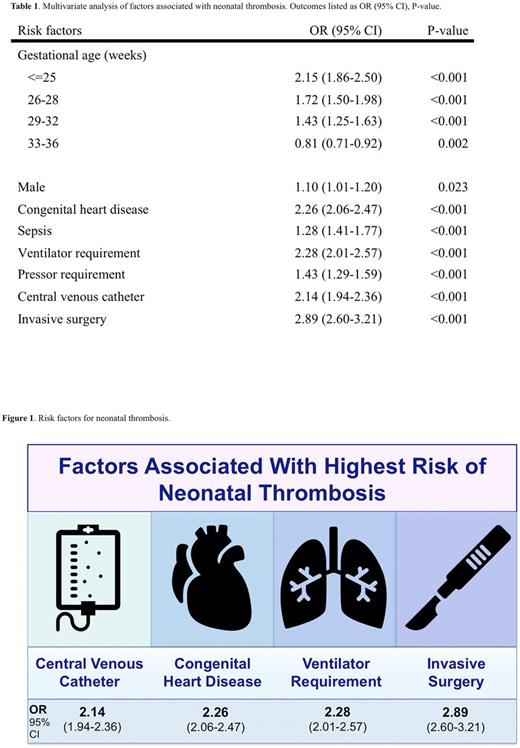Abstract
Background: Neonatal thromboembolism (TE), including both arterial and venous thromboses, causes significant morbidity and mortality in critically ill children. TE is thought to be rare in children compared to adults; however, the incidence is not precisely known. Predicting risk of neonatal TE is challenging due to the limited data available to characterize these infrequent events. Therefore, risk factors are often extrapolated from adult studies, though these may not apply uniformly to children. In contrast to adults; risk of TE in infants incorporates age related differences in vasculature and hemostasis, with a complex balance of pro- and anti-coagulant factors not accurately captured in standard lab tests. Evaluating the incidence of TE in a population-based sample will better define the scope of disease in order to improve strategies for management of thrombosis in the young. The aim of this study is to utilize a large national database to characterize the incidence and factors predisposing infants to TE.
Methods: The Pediatrix database was queried to identify all infants admitted to a neonatal ICU from 1997 through 2015 who subsequently developed venous and arterial TE. Demographic characteristics were assessed including sex, race/ethnicity, and birth weight, as well as previously described risk factors for TE including sepsis, pressor requirement, mechanical ventilation, and invasive procedures. Patient characteristics for the TE group were compared with the non-TE group using the Pearson X2 test for categorical variables and Wilcoxon rank-sum test for continuous variables. P-values <0.05 were considered statistically significant. Stepwise logistic regression was used to identify factors associated with neonatal thrombosis.
Results: Of 1,158,755 infants, 2367 (0.20%) were diagnosed with TE. On univariate analysis, early gestational age (in weeks, ≤25 1.6%; 26-28 0.8%; 29-32 0.2%; 33-36 0.1%; ≥37 0.1%, p<0.001), low birth weight (in g, <1000 1.3%; 1000-1499 0.36%; 1500-2499 0.1%; 2500-3499 0.1%; >3500 0.1%, p<0.001), male gender (0.21% vs. 0.19%, p=0.026), any congenital heart disease (0.72% vs. 0.15%, p<0.001), sepsis (1.52% vs. 0.17%, p<0.001), ventilator requirement (0.67% vs. 0.07%, p<0.001), pressor requirement (1.22% vs. 0.14%, p<0.001), presence of a central venous catheter (1.16% vs. 0.12%, p<0.001), and invasive surgery (1.29% vs. 0.11%, p<0.001) were associated with TE. On multivariate analysis, several of these factors remained significant with the strongest associations identified with central venous catheters, congenital heart disease, and invasive surgery (see Table 1). Primary medical management was anticoagulation; with higher rates of anticoagulant use in neonates with TE than those without (26.4% vs. 0.2%). However, type of therapy varied within the TE group and included unfractionated heparin (10.1%), low molecular weight heparin (20.3%), direct thrombin inhibitors (0.5%), and warfarin (0.4%). Overall mortality was increased in neonates with TE vs. those without (11.1% vs. 2.3%, p<0.001). Overall length of stay was significantly longer in neonates who developed TE (58 days, [IQR 29-101], p<0.001) compared to those who did not (11 days, [IQR 7-23], p<0.001).
Conclusion: This study, the largest national sample to date, demonstrates that arterial and venous TE in neonates are uncommon but associated with significant morbidity and mortality. Neonatal TE is associated with a number of independent risk factors including central venous catheters, congenital heart disease, and, notably, invasive surgery. Treatment strategies, primarily consisting of anticoagulation, vary considerably and have not been standardized. Moreover, consideration of thromboprophylaxis may be warranted in high-risk settings. Further study is needed to evaluate the safety and efficacy of therapy as well as to more precisely identify patients at risk of thrombosis, potentially with lab tests that examine dynamic changes in the coagulome.
No relevant conflicts of interest to declare.
Author notes
Asterisk with author names denotes non-ASH members.


